Book Review: Andre Agassi “Opens” Up
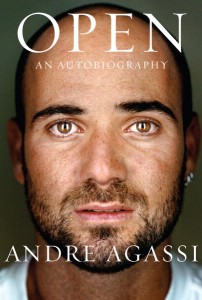
Andre Agassi uses his new book, Open, as a chance to purge his past and look toward the future.
Much has been written about the admission by Andre Agassi in his new autobiography, Open, that he regularly used crystal meth over a period of months in 1997.
While some may see that revelation as significant and choose to use it as an opportunity to pass judgment on Agassi, the incident is actually little more than a relevant footnote in a 386-page memoir that serves as a self-introduction by a person we all thought we already knew.
While there have been greater tennis players, no other tennis star has so permeated the fabric of American culture as has this flamboyant character from Las Vegas. For more than 20 years, Agassi has transcended tennis and in the process become one of those rare American sports icons that is known not only by fans of his particular sport, but also by people who would be shocked to learn that all tennis matches aren’t played on hard courts.
For that reason, Agassi has always resonated a strong opinion from a public that assumed they knew who he was and what he represented. After all, we first saw him as the flashy “Rebel” who had shoulder length hair and proclaimed that, “Image is Everything.” Then years later, without the hair, but still with the million dollar charm, he was transformed into the lovable veteran who defied father-time to stay competitive in a young-man’s game.
In Open, we learn that what we thought we knew was actually an illusion, a façade created by a person who spent much of his life living for someone else.
Some have asked why Agassi chose now to write this book and make revelations about drug use and other things during his career.
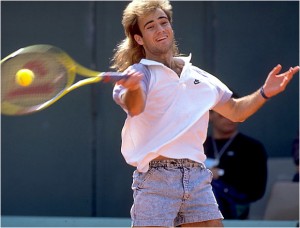
Image wasn't really everything for Agassi, but in 1989 his clothes and hair suggested otherwise.
After hearing Agassi in an interview describing the book and then reading his words, it seems apparent that Agassi wrote this book as much for himself as he did for his audience. This book is his purge of more than 30-years of memories, feelings and experiences.
Some are good, but many were obviously painful and traumatizing for a person who seemingly had little say in how much of his life transpired.
Basically from the time he could first stand, Agassi was pushed into the role of tennis prodigy by a father determined that one of his children would become a tennis superstar. A two-time Olympic boxer for his native country of Iran, Mike Agassi became obsessed with tennis and orchestrated Andre’s early life with the single goal of making him into a tennis champion.
It is in the early chapters where we begin to understand a far more significant revelation that Agassi shares with us in just the third paragraph of the book: that he hates tennis.
How can someone be so good and successful at something while at the same time hating it “with a dark and secret passion”?
While he never specifically answers that question, Agassi paints a picture of a world where tennis becomes both his oasis and his albatross. His talent provides Agassi with notoriety and eventually with money and fame, but it comes at a very high price.
To counter the domineering presence of both his father and later his first coach, Nick Bollettieri, young Andre becomes a rebellious 9th-grade dropout sporting long hair, earrings and occasionally even makeup.
Andre could have easily ended up like so many young prodigies pushed by obsessed adults, but instead of spiraling into a life of despair and disappointment, Agassi somehow managed to rise above the turmoil and eventually fulfill his potential.
While the early portion of the book includes significant venom directed at both his father and Bollettieri, Agassi changes his tenor midway through the memoir when he begins to describe the people that helped guide him through the pitfalls of youth and fame.
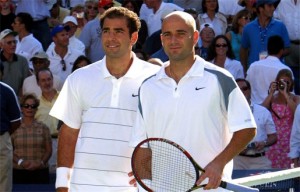
Agassi and Pete Sampras will forever be linked as the best players of their generation.
Ironically, what may have saved Agassi from early ruin was his personal insecurity and understanding of some of his own shortcomings. Instead of stubbornly refusing help and advice, he began to surround himself with people who not only watched his back and guided him through the potential hazards of stardom, but also understood his inner working and psyche.
Though it was clear from the very beginning that Agassi had the talent to be a superstar, it took him six years as a professional before he finally won his first major championship.
Andre describes the years leading up to his improbably victory at the 1992 Wimbledon with amazing detail and clarity. While his reputation was always as a carefree spirit and rebel, it is obvious through this book that Agassi was in reality much more a creature of habit than spontaneity.
However, he also was someone who could be distracted very easily and therefore bounced up and down the rankings like a pinball.
It was during one of those down periods, in 1997, that Agassi gave in to the temptation of recreational drug use. Always a tortured soul, it was probably inevitable that at some point Agassi would have an encounter with drugs.
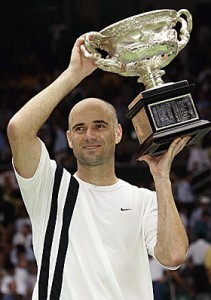
Agassi won the Australian Open four times, including in 2003 at the age of 32.
Granted he is looking back more than ten years after the fact, but Agassi seems most embarrassed not necessarily with the fact that he turned to drugs during a trying time in his career, but that he lied about the use to ATP officials and then got away with it.
As some of his critics point out, Agassi’s career certainly might have unfolded differently had he been suspended for his positive drug test. However, even before he was given a reprieve by the ATP, Agassi had used the incident as a personal wake-up call and was on the way to forever changing his approach and career.
Another interesting element of the book is the detail in which he describes his relationships with his first wife, Brooke Shields, and his second wife, Stefanie (Steffi) Graf.
Like Agassi, both were products of obsessed parent that guided their child to succeed and were ultimately robbed of their own childhoods.
One of the funniest stories in the book is the initial meeting between Graf’s father, Peter Graf, and Agassi’s own dad. Suffice to say, Agassi may have been lucky that no blood was spilled.
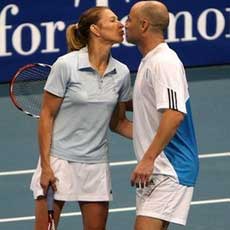
In retirement Agassi and his wife, Stefanie Graf, can be much more relaxed on the tennis court than during their high-profile careers.
What becomes clear towards the end of the book is that though Agassi may hate tennis with a passion, whether he likes it or not he also loves tennis and the competition that it generates.
How else can you describe that while his contemporaries were retiring, Agassi was training like never before to stay near the top as long as possible?
After having played tennis initially for his father and then later because he didn’t know what else he could do, over the final years of his career it seems that Agassi was finally playing for himself.
Between the ages of 29 and 33, Agassi claimed five grand slam titles and became one of only three players to win all four majors. In 2005, at the age of 35, he became the oldest Grand Slam finalist when he lost to Roger Federer in the finals of the U.S. Open.
Agassi calls the final chapter of the book “The Beginning” and it is clear that life after professional tennis is a life that he is very much excited about. Between his charity work and family, Agassi is now living a life in which he has found love and peace and is able to make a difference in the lives of many.
But before Agassi could forever live his new life to the fullest he had one last duty to his old one.
Coming clean on his dark little secrets through Open is that duty.
He has now expunged the past and can move forward in peace. Peace with himself and peace with tennis.
Excellent review. I am anxious to read this book and it is high on my list of priorities. You captured the tenure of it very well and it is my hope that once people read "Open" the criticism of Agassi will end.
Great read, Dean.
I'm perfectly okay with Agassi purging his soul by writing this book. I'm not sure what all the criticism was all about. He had a means to do so and he took it. I couldn't agree with you more that he wrote this book more for himself than anything else.
Chris
sportschump.net
Between me and my husband we’ve owned more MP3 players over the years than I can count, including Sansas, iRivers, iPods (classic & touch), the Ibiza Rhapsody, etc. But, the last few years I’ve settled down to one line of players. Why? Because I was happy to discover how well-designed and fun to use the underappreciated (and widely mocked) Zunes are.
Hallo Admin , i love with u site. LOL Please come to my blog
hey Friend , i like with u article. LOL Please come to my blog
I recently discovered your blog publish and still have been recently looking at along. You’ll find several odd responses, however in most cases I’ve got to agree with the other rewiewers are producing. Experiencing countless greatgreat testimonials involving this site, I thought that I ought to additionally participate in along with tell you that I must say i loved perusing this your articles. So i think this could make my personal very first comment: “I can see that you’ve produced a number of actually exciting points. Very few folks would likely truly consider this how you just did. I am just actually pleased that there’s a lot relating to this topic that’s been uncovered and you made it happen so effectively, with much training!”
Weird , your site turns up with a black hue to it, what color is the primary color on your web-site?
dj equipments that are built by Sennheiser are the best in my opinion, we always use them when we have a gig,แทงมวย
you have got a wonderful weblog here! do you need to develop invite posts on my own blog?you have got a wonderful weblog here! do you need to develop invite posts on my own blog?리니지m 다이아 매입리니지m 다이아 매입
Malcolm you write in a lucid manner and I have no difficulty to understand what you have said, even though I am a novice.구글 seo 최적화
aspirin has been time tested to relieve minor pains and inflammation and it is cheap too::The hidden wiki link
The movie follows three decent working-class guys played by Jason Bateman, Jason Sudeikis, and Charlie Day.STOPWATT REVIEWS